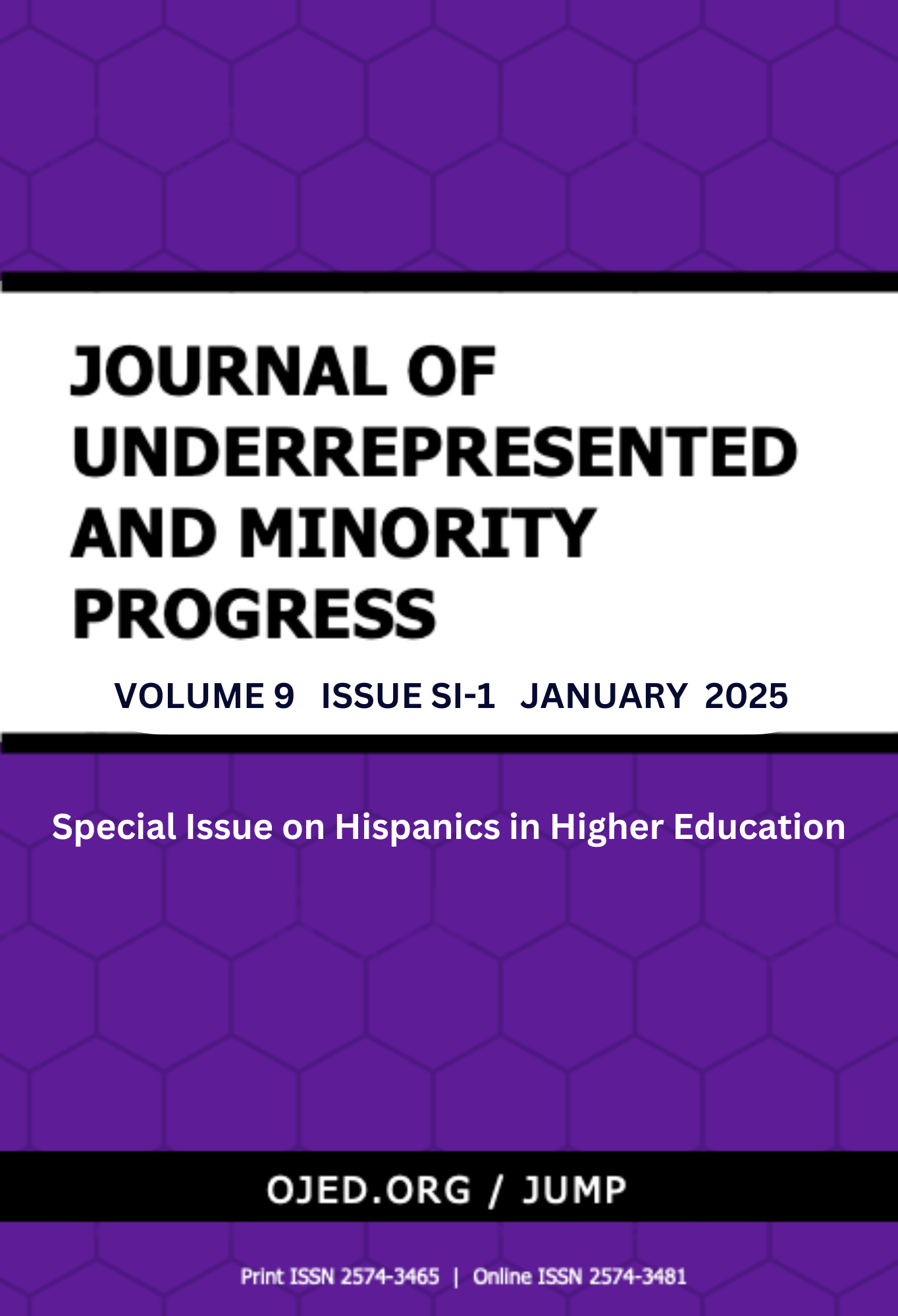Madison Hispanic Caucus (MHC): Impact and Retention of Hispanic Faculty and Staff
DOI:
https://doi.org/10.32674/ke4kme83Keywords:
Affinity groups, Comunidad, Diversity, Higher education institutions, Hispanic faculty and staff, Peer networks, Sense of belongingAbstract
Knowing by first-hand experience how difficult it can be to be a minority on campus, we, as the authors, focus on the impact of having a Hispanic caucus for faculty and staff in a predominantly white institution. This study explores the impact of the caucus on its members, both professionally and personally. It also examines how caucus’ membership helps build a comunidad on and off campus. Our findings indicate that the caucus positively impacts its members and allows them to build a comunidad, networks, and collaborations. We concluded that affinity groups are vital for underrepresented populations. Therefore, higher education institutions should prioritize allocating resources and creating safe and inclusive spaces specifically for Hispanic faculty and staff.
References
Bitar, J., Montague, G., & Ilano, L. (2022). Faculty diversity and student success go hand in hand, so why are university faculties so white?. The Education Trust. https://edtrust.org/wp-content/uploads/2014/09/Faculty_Diversity_Report_FINAL-3.pdf
Bourdieu, P. (1986). The forms of capital. In J. Richardson (Ed.). Handbook of theory and research for the sociology of education (pp. 241-258). New York: Greenwood.
Cambridge Dictionary. (n.d.). Impact. In Dictionary.cambridge.org dictionary. Retrieved September 10, 2023, from https://dictionary.cambridge.org/us/dictionary/english/impact#
Chattopadhyay, D. (2022). Exploring effects of institutional, interpersonal, & individual communication on university students’ attitudes about diversity and institutional belongingness. Intercultural Communication Education, 5(2), 39-58. doi: 10.29140/ice.v5n2.627
Comer, E. W., Medina, C. K., Negroni, L. K., & Thomas, R. L. (2018). Women faculty of color in a predominantly white institution: A natural support group. Group Work Stories Celebrating Diversity, 162-169.
Creswell, J. W., & Guetterman, T. C. (2019). Educational research: Planning, conducting, and evaluating quantitative and qualitative research (6th ed.). Pearson.
Cushner, K. (2015). Development and assessment of intercultural competence. In M. Hayden, J. Levy, & J. Thompson (Eds.), The SAGE handbook of research in international education (2nd ed., pp. 45–58). Sage.
Dias, T. W. (2017). Experiences of Latino community college students in overcoming barriers to persist. Journal of Underrepresented and Minority Progress, 1(1), 52-65. doi: 10.5281/zenodo.1165454
Espinosa, L. L., Turk, J. M., Taylor, M, & Chessman, H. M. (2019). Race and Ethnicity in Higher Education: A Status Report [Postsecondary faculty and staff]. American Council on Education. https://www.equityinhighered.org/wp-content/uploads/2019/02/REHE-Chapter-10-SA.pdf
Goldhaber, D., Theobald, R., & Tien, C. (2015). The theoretical and empirical arguments for diversifying the teacher workforce: A review of the evidence. In The Center for Education Data & Research. https://citeseerx.ist.psu.edu/document?repid=rep1&type=pdf&doi=e064c83b3b8aefbb0e9b7d5d90c09faf96987df3
Heilig, J. V., Flores, I. W., Barros Souza, A. E., Barry, J. C., & Monroy, S. B. (2019). Considering the ethnoracial and gender diversity of faculty in United States college and university intellectual communities. Hispanic Journal of Law and Policy, 2019, 1-31.
Hispanic Association of Colleges and Universities. (2023). Hispanic higher education and HSIs facts. https://www.hacu.net/hacu/HSI_Fact_Sheet.asp
Hurtado, S., Milem, J. F., & Clayton-Pedersen, A. R. (1998). Enhancing campus climates for racial/ethnic diversity: Educational policy and practice. Review of Higher Education, 21, 279-302. doi: 10.1353/rhe.1998.0003
Hurtado, S., Milem, J. F., Clayton-Pedersen, A. R., & Allen, W. R. (1999). Enacting diverse learning environments: Improving the campus climate for racial/ethnic diversity in higher education. ASHE-ERIC Higher Education Report Series No. 26-8. San Francisco, CA: Jossey Bass.
Kirshstein, R. J., Matheson, N., Jing, Z., & Zimbler, L. J. (1997). Instructional faculty and staff in higher education institutions: Fall 1987 and fall 1992. http://www.ed.gov/NCES
López, R. M., Honey, M. L., Pacheco, H. S., & Valdez, E. C. (2021). Creando comunidad: Experiences of Latina faculty and staff mentors at a Hispanic-serving institution. Journal of Women and Gender in Higher Education, 14:1, 100-120. doi: 10.1080/26379112.2021.1888746
Maestas, R., Vaquera, G. S., & Múñoz Zehr, L. (2007). Factors impacting sense of belonging at a Hispanic-serving institution. Journal of Hispanic Higher Education, 6(3), pp. 237-256. doi: 10.1177/1538192707302801
Mertler, C.A. (2020). Action Research: Improving Schools and Empowering Educators (6th ed.), Thousand Oaks, California: Sage Publications.
Mishra, S. (2020). Social networks, social capital, social support and academic success in higher education: A systematic review with a special focus on ‘underrepresented’ students. Educational Research Review, 29. doi: 10.1016/j.edurev.2019.100307
Montas-Hunter, S. S. (2012). Self-efficacy and Latina leaders in higher education. Journal of Hispanic Higher Education, 11(4), 315-335. doi: 10.1177/1538192712441709
National Center for Education Statistics. (2022). Full-time faculty in degree-granting postsecondary institutions, by race/ethnicity, sex, and academic rank: Fall 2019, fall 2020, and fall 2021. https://nces.ed.gov/programs/digest/d22/tables/dt22_315.20.asp
Neal, L., Sleeter, C., & Kumashiro, K. (2015). Why a diverse teaching force must thrive. In C. Sleeter, L. Neal, & K. Kumashiro (Eds.), Diversifying the teacher workforce (pp. 1–16). Routledge.
Núñez, A.-M., Murakami, E. T., & Gonzales, L. D. (2015). Weaving authenticity and legitimacy: Latina faculty peer mentoring. New Directions for Higher Education, 171, 87-96. doi: 10.1002/he.20145
Ouyang, J. X., & Chanani, S. (2023). Taking care of our own: Asian American, and Pacific Islander faculty affinity group formation. Academic Psychiatry. doi: 10.1007/s40596-023-01788-4
Pour-Khorshid, F. (2018). Cultivating sacred spaces: a racial affinity group approach to support critical educators of color. Teaching Education, 29(4), 318-329. doi: 10.1080/10476210.2018.1512092
Settles, I. H., Jones, M. K., Buchanan, N. T. & Brassel, S. T. (2022). Epistemic exclusion of women faculty and faculty of color: Understanding scholar(ly) devaluation as a predictor of turnover intentions. The Journal of Higher Education. 93(1), 31-55. doi: 10.1080/00221546.2021.1914494
Spencer, M. B. (2017). Expanding the conversation, extending the argument: The role of conceptual frameworks in presenting, explaining, and contextualizing findings. In S. M. Ravitch, & M. Riggan (Eds.), Reason & rigor (2nd ed., pp. 139-168). Sage.
Vásquez-Montilla, E., Wilder, L. K., & Triscari, R. (2012). Ethnically diverse faculty in higher ed: Belonging, respect, and role as cultural broker. Multicultural Learning and Teaching, 7(1). doi: 10.1515/2161-2412.1097


